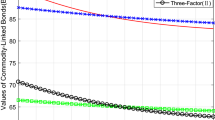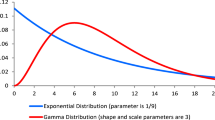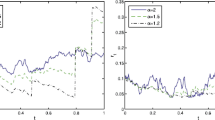Abstract
In this paper, we introduce a joint bond and stock market model based on the state price density approach as a mean to discount future payments—whether these are stochastic dividend payments or secure repayments of government zerobonds. Based upon a recipe of Rogers [20], we define a state price density model, the so-called Hyperbolic Gaussian model which allows for closed form zerobond prices and stock prices in an arbitrage-free way. It is particularly useful for insurance applications where large time horizons are considered. We estimate the joint factor model using the extended Kalman filter. The model we propose here is computationally much simpler than other models which have been considered in the literature.


Similar content being viewed by others
Notes
Note that the same definition of the dividend payment process may also be used to expand Rogers [20] first and second examples which specify \(f(x):=\exp{x}\) and \(f(x):=\exp\left(c+x' Q x\right), \) respectively.
References
Albrecht P (2007) Einige Überlegungen zur simultanen Modellierung von Aktienindex und Zinsstruktur. Mannheimer Manuskripte zu Risikotheorie. Portfolio Management und Versicherungswirtschaft
Brigo D, Mercurio F (2001) Interest rate models: theory and practice. Springer, Heidelberg
Cairns AJG (2004) A family of term-structure models for long-term risk management and derivative pricing. Math Financ 14:415–444
Cairns AJG (2008) Interest rate models. Princeton University Press, Princeton
Dai Q, Singleton KJ (2000) Specification analysis of affine term structure models. J Financ 55:1943–1978
Duffee GR (2002) Term premia and interest rate forecasts in affine models. J Financ 57:405–443
Duffie D (1992) Dynamic asset pricing. Princeton University Press, Princeton
Duffie D, Kan R (1996) A yield-factor model of interest rates. Math Financ 6:379–406
Filipovic D (2009) Term-structure models. Springer, Berlin
Fisher I (1930) The theory of interest. The Macmillan Co., New York
Flesaker B, Hughston L (1996) Positive interest. Risk 9(1):46–49
Gordon M (1959) Dividends, earnings, and stock prices. Rev Econ Statistics 41:99–105
Graziano GD, Rogers L (2006) Hybrid derivatives pricing under the potential approach. Working paper, University of Cambridge, Cambridge
Harvey AC (1991) Forecasting, structural time series models and the Kalman filter. Cambridge Books, Cambridge University Press, Cambridge
Kellerhals BP (2001) Financial pricing models in continuous time and Kalman filtering. Lecture notes in economics and mathematical systems, Springer, Berlin
Litterman R, Scheinkman J (1991) Common factors affecting bond returns. J Fixed Income 1:62–74
Musiela M, Rutkowski M (2005) Martingale methods in financial modeling. In: Stochastic modelling and applied probability, vol 36. 2 edn, Springer, Berlin
Pfeiffer R (2010) State price density models for the term structure of interest rates. Applications to insurance and expansions to the stock market macroeconomic variables. http://www.digbib.ubka.uni-karlsruhe.de/volltexte/1000019585. Ph.D. thesis, KIT
Rebonato R (2002) Modern pricing of interest-rate derivatives: the Libor market model and beyond. Princeton University Press, Princeton
Rogers L (1997) The potential approach to the term structure of interest rates and foreign exchange rates. J Math Financ 7:157–176
Rutkowski M (1997) A note on the Flesaker-Hughston model of the term structure of interest rates. Applied Math Financ 4(3):151–163
Wilkie AD (1984) Steps towards a comprehensive stochastic model. Research discussion paper, The Institute of Actuaries, London
Wilkie AD (1986) A stochastic investment model for actuarial use. Trans Faculty Actuaries 39: 341–403
Wilkie AD (1995) More on a stochastic asset model for actuarial use. Br Actuarial J 1:777–964
Yao Y (1999) Term structure modeling and asymptotic long rate. Insurance: Mathematics and Economics 25:327–336
Yao Y (2001) State price density, Esscher transforms, and pricing options on stocks, bonds, and foreign exchange rates. N A Actuarial J 5:104–117
Author information
Authors and Affiliations
Corresponding author
Additional information
The underlying project is funded by the Bundesministerium für Bildung und Forschung of Germany under promotional reference 03BAPAD2. The authors are responsible for the content of this article.
Appendix
Appendix
The proof of Theorem 2.7 is as follows:
Proof
Using the Itô-Doeblin formula it is easy to see that the state price density
satisfies the SDE
Since \(\langle V \rangle_{t}=\|\hat{C}\|^2 t \) we obtain
In view of Corollary 2.5 we obtain
Let us denote by \(\mathcal{E}(X)\) the stochastic exponential of the process X. Since \(\int_0^\cdot r_sds\) is of bounded variation we obtain
If we define \(B_t = \exp\Big(\int_0^t r_s ds\Big)\) and \(L_t := \mathcal{E}(\int_0^\cdot \tanh(V_s+c)\hat{C}dZ_s)_t\) we obtain \(\varsigma_t = B_t^{-1} L_t. \) Note that since \(\tanh\) is bounded, (L t ) is an \((\mathcal{F}_t)\)-martingale with expectation 1. Hence we can define the probability measure \({\mathbb{Q}}\) by \({\frac{d\mathbb{Q}}{d\operatorname{\mathbb{P}}}\big|_{\mathcal{F}_t}=L_t. }\) Note that \({\mathbb{Q}}\) does not depend on T. From the Bayes formula we obtain
Hence the discounted bond price is a martingale under \({\mathbb{Q}}\) which shows that the market is free of arbitrage.□
The proof of Theorem 3.2 is as follows:
Proof
It is sufficient to show that \({\varsigma^{-1}B_t^{-1} \operatorname{\mathbb{E}}[\varsigma_{\tau_n} D_{\tau_n} | \mathcal{F}_t]}\) is a \({\mathbb{Q}}\)-martingale for the same \({\mathbb{Q}}\) as in the proof of Theorem 2.7. However, the Bayes formula again implies
which implies the statement.□
Rights and permissions
About this article
Cite this article
Bäuerle, N., Pfeiffer, R. A Joint Stock and Bond Market based on the Hyperbolic Gaussian Model. Eur. Actuar. J. 3, 229–248 (2013). https://doi.org/10.1007/s13385-012-0060-6
Received:
Revised:
Accepted:
Published:
Issue Date:
DOI: https://doi.org/10.1007/s13385-012-0060-6




